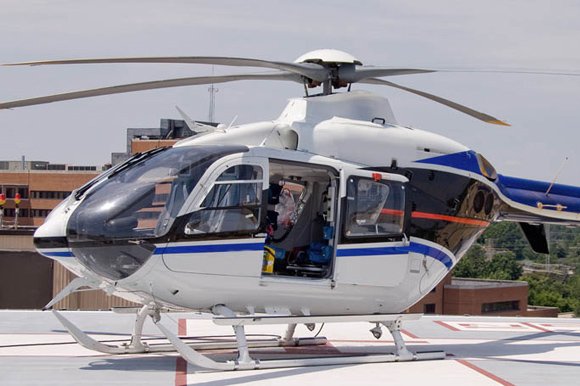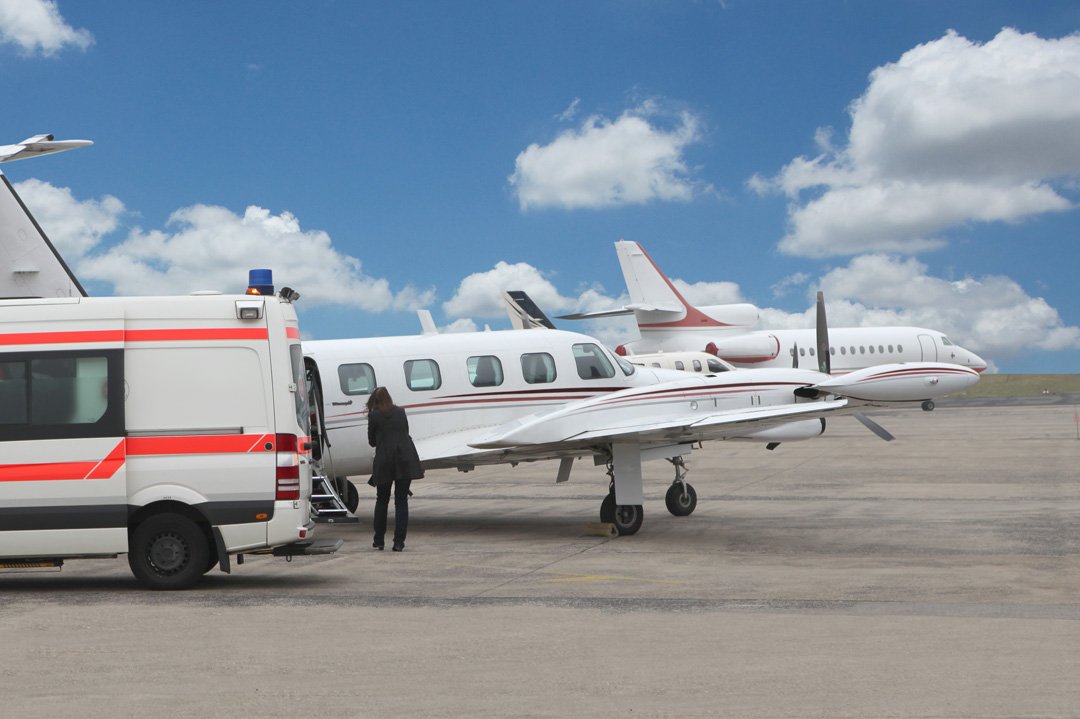Reading Time: 5 minutes
Table of contents
- Medical Air Service: Our aircraft fleet and related air medical services
- When should you request a helicopter, a fixed-wing ambulance, or a medical escort?
- When do you need a helicopter ambulance?
- When do you need a plane ambulance?
- When do you need a commercial airline medical escort?
- How does our medical escort service work?
- Do you have any additional questions?
- Contact us now
Aeromedical transportation is a common method of transporting patients whose medical conditions prevent them from traveling long distances on land. It is usually intended for patients who need to be transferred safely and quickly from one care facility to another, usually in a foreign country or back to their home country, all while requiring extensive or intensive in-flight medical care. Medical Air Service’s aircraft are manned by a medical flight crew and transport equipment such as a CPR kit, an ECG and other monitoring units, respirators, and specific medication for this purpose. We typically use two types of air ambulances for our medical transport missions: fixed-wing and rotor-wing aircraft, in addition to providing medical escort services. Because each patient's situation and needs are unique, choosing the best out of these three options is critical. A number of factors, which are listed in this article, should be considered in order to make the best decision.
Medical Air Service: Our aircraft fleet and related air medical services
Our international clients benefit from a wide range of air ambulance services, allowing us to exceed their expectations. But what exactly is an "air ambulance"? When the term is used, it is essential to comprehend that it refers to a wide range of aircraft dedicated to medical purposes. These aircraft are classified as either rotary-wing or fixed-wing, and are “specially outfitted to transport sick or injured people in a medical emergency or over distances or terrain that conventional ground ambulances would find impractical."
Rotary-wing Ambulances (helicopters)
As it is well known, rotary-wing aircraft, such as helicopters, are propelled by rotating blades. These types of air ambulances are most commonly used in emergency situations, particularly when someone needs to be transported as quickly as possible over a distance that cannot be reasonably covered by a traditional ground ambulance. Furthermore, because of their ability to land almost anywhere, they are useful in situations where a traditional ambulance would have difficulty accessing the patient.
Good to know: It is worth noting that, despite having a helicopter fleet, Medical Air Service does not specialize in emergency missions.

Fixed-wing Ambulances (planes)
With wings that do not move, fixed-wing aircraft are powered by a jet engine or a propeller that allows them to fly faster than helicopters. They are also commonly preferred to rotary-wing aircraft for long-distance patient transfer due to their ability to travel further before needing to refuel.
Another significant advantage of fixed-wing air ambulances over rotary-wing aircraft is their ability to fly in adverse weather conditions, thus resulting in fewer delays when moving a patient from one facility to another. Furthermore, fixed-wing air ambulances, as one might expect, have a much larger interior than helicopters, allowing them to transport more medical equipment and personnel. And because they can fly at higher altitudes, they also guarantee a less turbulent ride, resulting in a more comfortable experience for patients.
Medical Air Service's air ambulance fleet includes the Bombardier Challenger 650, the Dassault Falcon 50 or the Dornier Jet 328-300. They come fully equipped with medical equipment and a crew that is highly trained and experienced. We have all of the technology needed to get our patients to the appropriate healthcare facility as quickly as possible. Contact us today to book a flight or learn more about our aircraft.
Another one of our air medical services that may be of interest to you if you encounter any kind of health problem while traveling abroad is the following:
Commercial Airline Medical Escorts
Some patients whose mobility is impaired do not necessarily require an air ambulance response. A medical escort service may be their best option, especially if they can sit up, without assistance, during the take-off and landing. It is also a cost-effective method of safely transporting patients with limited medical needs who meet the minimum requirements of commercial airlines.
If you are wondering how Medical Air Service’s medical escort service works, the patient is accompanied by at least one member of our medical team throughout the trip. The service also includes in-flight care as well as bed-to-bed services provided by a ground ambulance. More on this in the second part of this article.
When should you request a helicopter, a fixed-wing ambulance, or a medical escort?
Plane and helicopter ambulances, as well as commercial airline medical escort, are part of our medical services. Different circumstances, however, necessitate the use of one of these specific services. When deciding between these three options, a few factors must be considered. The distance to be traveled, the patient's health condition, the location of the treatment center, medical care requirements, and even airport runways are all variables.
When do you need a helicopter ambulance?
At Medical Air Service, our helicopters are used for inter-hospital transfers over short distances. As previously stated, they can take off and land almost anywhere. Indeed, our helicopters may be the most convenient option if a stable patient needs to be moved over a distance of fewer than 100 miles, and their condition is not subject to complications by increases in altitude.
When do you need a plane ambulance?
Medical Air Service’s fixed-wing aircraft are typically used for non-emergency medical air transport. They have been shown to be effective in the following scenarios:
Long-distance patient transfers and complex medical conditions
Our fixed-wing ambulances are preferred for long-distance patient transfers, because in the end, helicopters are slower and more expensive, and have a smaller range than an ambulance jet.

Adverse weather conditions
In contrast to helicopters, fixed-wing ambulances are designed to withstand adverse weather conditions such as:
- Frost: After take-off, as the aircraft climbs in altitude and the temperature drops, frost is a cause for concern, especially when humidity is high. To alleviate this inconvenience, fixed-wing aircraft have inflating pneumatic boots or can heat the wing's edge, both of which are anti-icing technologies that helicopters lack;
- Heavy rain, fog and snow are weather conditions during which helicopters struggle to land, again because they do not have the electronic equipment that allows pilots to gauge conditions even when their vision is obscured. Fixed-wing ambulances are equipped with such an IVF system, though they, too, must exercise extreme caution during take-offs and landings due to slick conditions
Financial considerations
Indeed, chartering a fixed-wing aircraft is significantly less expensive than chartering a helicopter, especially for medical purposes.
When do you need a commercial airline medical escort?
Customers can reduce flight risks on a commercial airline by hiring a dedicated medical escort to assist them.
Our commercial airline medical escort services can benefit patients with orthopedic injuries or other mobility issues, patients with behavioral health issues such as Alzheimer's or dementia, as well as cancer patients and patients with other special needs.
However, some patients should not be escorted on a commercial airline:
- Patients with behavioral issues who act out are typically not allowed to fly on a commercial airline.;
- Because of cabin pressure drops at altitude, patients who are more than seven months pregnant are too vulnerable to fly commercially;
- Patients with intestinal blockages or who have recently undergone surgery are also prone to complications caused by airline pressure drops when flying commercially;
- Patients who require oxygen cannot fly on a commercial plane;
- Patients who require intensive care that cannot be provided on commercial planes;
- Patients who need to be transferred as fast as possible, without delays and transits.

How does our medical escort service work?
A paramedic will drive the patient to the airport in a ground ambulance. He will take care of the latter’s luggage and hygiene needs before escorting him through security to the gate to a first or business class seat on the commercial airliner. The patient will be able to lie down in a seat that reclines to a lying position for the majority of the journey.
Our medical escort will attend to the patient's comfort and basic medical needs during the flight, and take regular vital signs to ensure his stability and provide any necessary medications. He will also help the patient exit the plane and retrieve any checked luggage. The paramedic will then board the pre-arranged ambulance and accompany the patient to their destination.
Medical Air Service employs a plethora of skilled personnel who devote their full attention to the patient’s care, safety and comfort, while adhering to strict medical protocols. By using our commercial airline escort services, you can be confident that we will handle all other aspects of your trip, including bed-to-bed services, ticketing, check-in, security, luggage, boarding, and deplaning.
Before accepting a mission, Medical Air Service always assesses a patient's condition. We will not hesitate to recommend a helicopter flight if it is the quickest and most necessary course of action. We provide exceptional services in situations where a fixed-wing aircraft is required. Every flight includes critical care trained personnel as well as two pilots.
Do you have any additional questions?
Please visit our FAQ page if you were unable to find what you were looking for in this article.
Contact us now
Our platform is operational 24 hours a day, seven days a week. Please contact us as soon as possible for more information on the cost of your medical repatriation or to arrange for an air ambulance flight.
Get in touch now